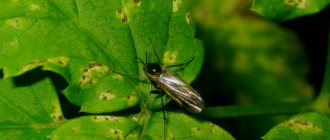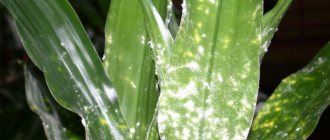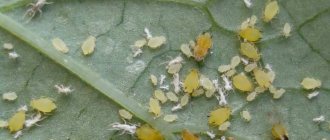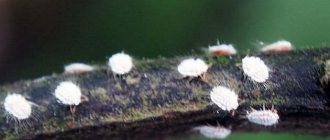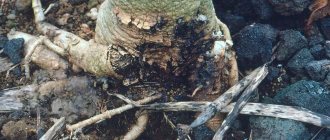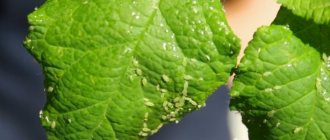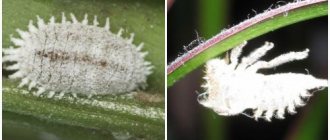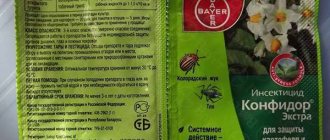All scale insects and false scale insects cause enormous damage to plants. The signs accompanying them are characteristic of all types of scale insects. At the site where the scale insect is sucked, yellow spots appear on the leaves, which grow in size as the juice is sucked out, then the leaf turns completely yellow, curls and falls off. The plant stops growing, the branches become bare, then the entire bush begins to dry out and the plant dies. In addition to leaves, the scale insect damages the fruits of tangerines, lemons and oranges.
Brown scale insect (Chrysomphalus dictyospermi). © fturmo
Scale insects - description
Scale insects , Latin name – Diaspididae. A family of hemiptera insects from the superfamily of scale insects. There are over 2400 species in the family. The body is covered on top with a waxy shield (hence the name of the insect).
All scale insects are distinguished by the fact that they have protective shields and look like plaques on the plant. The mouthparts of all scale insects are sucking. They differ only in size and color. The scale insect is especially dangerous because just a few hours after hatching from the eggs, the larvae are already settling throughout the plant and immediately begin to suck all the juices out of it, and the leaf surface is completely covered with scutes.
The brown scale insect (Chrysomphalus dictyospermi) damages mainly leaves, settling on their upper side. The scutellum of the adult female is round, about 2 mm in diameter, reddish-brown or dark brown. The male's scutum is smaller and oblong in shape.
What does it look like
Let’s first consider the structure of the females - by the way, most “lovers” of indoor plants have an external similarity:
- legs, wings, eyes, antennae are absent, but there are well-developed mouthparts of the piercing-sucking type;
- the young have a soft scutum and are able to move, then the scutum matures and the females no longer move;
Did you know? Among all terrestrial animals, female coccids, including scale insects, are the only group that “evolves” to a sedentary lifestyle, which is accompanied by non-stop feeding.
- body length 1.5-2 mm, oval or round shape, segmentation is not expressed (horticultural crop eaters are larger, with a pear-shaped or teardrop-shaped body up to 5 mm long);
- body color under the shield is white or pale brown;
- the scutellum in mature individuals covers the surface of the body completely or partially, can be highly convex, hemispherical or flattened and consists of a secretory part and larval skins;
- the color of the shield is yellowish-brown and dark brown; During the maturation of the larvae, the color of their skin may change, and the scutellum is correspondingly colored - heterogeneously, for example, a golden brown outer ring with a dark brown central one.
Now the males:
- there are no oral organs - but there are eyes and fully formed limbs and wings;
- the body is segmented: head, chest and abdomen;
- usually white and fluffy, but can be reddish, red-gray and light orange;
- There is a small shield available.
Scale insects hatch oval or elongated oval-shaped eggs, usually white or light gray in color, turning into light brown over time. The size of the eggs is tiny: from 0.1 to 0.3 millimeters. Under a microscope, they can be confused with worms. The larva comes in two instars:
first instar (such larvae are called wanderers) - a yellowish body, oval and flattened, up to 0.3 mm long, there are three pairs of legs, as well as antennae and eyes;
Did you know? Pay attention to the color of the larva - in the case of many species of Diaspididae, you can understand what it will regenerate into. For example, white mulberry scale insects grow into females, and red ones grow into males.
second instar - the body size is larger, up to 0.5 millimeters, the color is white or gray with, as a rule, a darker rear part of the body, usually there are no legs, antennae, or eyes. The only thing that distinguishes such larvae from mature individuals is their size and scutellum: it is lighter.
Do not forget about the species diversity of scale insects: females of some species are almost transparent, their shield is difficult to distinguish; come with broken, blot-shaped bodies; someone has a poisonous black shield, and so on. The same applies to morphological development: for example, some tropical Diaspididae lack the egg stage.
False shields - description
False scale insects differ from true scale insects in that they do not have a waxy shell, and the eggs and larvae are protected by the drying skin of the dying female.
False scale (Coccidae). © James Clay
False scale insects , or coccids (Coccidae) are a family of hemiptera insects from the superfamily of scale insects. Over 1,100 species have been described, of which about 150 species are found in Europe.
Prevention measures
It is better to prevent than to deal with the consequences. This expression is true in the case of a false scale insect. You can prevent its occurrence in two simple ways.
Quarantine . The most active tramp will never get into the house on his own. Therefore, you need to purchase plants only from trusted places. After the new green pet is brought in, it should be thoroughly examined and quarantined for several weeks.
Care . A weakened plant may develop diseases and pests. Therefore, timely hygiene procedures will help maintain immunity. Pets are properly planted, fed regularly, watered and sprayed in a timely manner.
Reproduction of scale insects and false scale insects
Most species of scale insects reproduce by laying eggs, but there are also viviparous species. Pests live on the underside and top of leaves, shoots and trunks of plants. Only young larvae settle, sticking to various parts of the plant; adult insects are not mobile.
With severe infection, the leaves along the veins and plant trunks become covered with a coating formed from a large accumulation of scale insects. Damaged plants have stunted growth and development, leaves turn yellow and fall off prematurely.
Scale insects and false scale insects secrete a sticky liquid - honeydew, on which a sooty fungus settles, which further impairs the development of plants.
Scale insects and false scale insects damage many indoor plants: palm trees, citrus fruits, oleander, ivy, cyperus, asparagus, aucuba and others.
Adults and larvae function all year round, sucking cell sap from the plant. Damaged plants turn yellow, develop incorrectly, leaves often fall off, and young shoots dry out.
Scale insects belong to fast-growing pests. Reproduction can be either asexual or conventional. It occurs by laying eggs under the scutellum, and some species are viviparous. After hatching, the scale insect goes through several stages of development. At the initial stage, scale insects are very mobile and can quickly spread, in particular to neighboring plants.
Females are immobile, but males can even fly during their lives. However, the life cycle of the male is very short. They live only a few days, unlike females, who live for several months.
Under good conditions, more females are born; under bad conditions, more males are born. The composition of the population changes itself in such a way as to improve its mobility and move to a more favorable place for life.
Ficus leaf infected with false scale insects. © Karl Magnacca
Kinds
There are about a thousand species of pests found in nature. Here is a list of the most famous.
Spruce
It mainly affects plants of coniferous forests up to ten years old. Dangerous, spreads quickly.
Acacia
Fruit, berry, and ornamental species such as acacia, apple, gooseberries, currants, etc. are at risk.
Japanese wax
All varieties of citrus fruits and tropical crops are affected.
Soft
This type of false scale insects prefers to feed on house flowers and plants. The most unprotected.
Measures to combat scale insects and false scale insects
Scale insects are protected from external influences by a shield, so fighting them is not easy. Scale insects are cleaned with a toothbrush or a cloth soaked in an alcohol or soap solution; you can also use a soap-kerosene emulsion.
Alcohol solution with soap . The mixture consists of 15 grams of liquid soap, 10 ml of denatured alcohol and 1 liter of warm water. However, you need to be very careful here, especially for soft-leaved and thin-leaved plants. These species are very sensitive to alcohol, so they do not spray the liquid, but apply it to the insects themselves with a brush. If you really want to use this method, it is best to do a small sensitivity test on one sheet first.
In case of severe damage, the following chemicals are used:
"Aktellik". Dilute the ampoule in 1 liter of water and treat during the period when the pest appears. Solution consumption up to 2 liters per 10 sq.m. No more than 4 treatments. The waiting period is 3 days.
"Phosbecide." Treatment with these drugs (they are toxic) is best done outdoors (20 ml per 10 liters of water).
Scale insects. © Jeffrey W
If the plants are short (up to 30 cm), try watering them at the root with a solution of the drug "Aktara" . This insecticide penetrates the plant through the roots and makes all its above-ground organs toxic to insects for some time. When treating with an insecticide, wipe the window sill or shelf where the plant stood, as well as the window glass, as small larvae may not be noticed.
To reduce the harmfulness of scale insects and false scale insects, one can also use the fact that the reproduction of many species of these pests is greatly slowed down by a drop in relative air humidity and prolonged exposure to sunlight. Therefore, be moderate with watering, avoid crowding of plants, ventilate the room more often, isolate the infected plant from others, and move it to a more illuminated place.
Preventive actions
Following some rules for caring for indoor plants will help prevent the appearance of pests such as scale insects. When purchasing new flowers, they should not be immediately installed next to indoor plants. It’s better to play it safe and quarantine them in a separate place for a while. To prevent the appearance of pests, it is better to regularly ventilate the premises and spray indoor plants with water.
Scale insects are dangerous because they suck out all the juices from the plant, which leads to the death of indoor flowers. Untimely destruction of such parasites causes significant harm to your home flower collection. Everything that is grown with such difficulty can instantly turn into sick, dying plants that can no longer be saved. Therefore, regular inspection of indoor flowers will help to detect dangerous insects in a timely manner and can protect ornamental plants from death.
Scale insects pose a great danger not only to indoor ornamental plants, but also to garden flowers. If the parasite is not identified in time, it will destroy almost all flowers and other garden crops in the garden.
A simple way to fight scale insects
